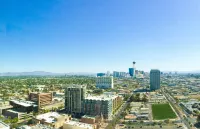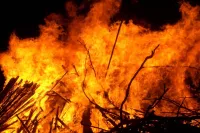1915: Las Vegas Cowboys' Reunions Begin
The Las Vegas Cowboys' Reunions were first held in 1915 and continued annually until 1931.
1931: Las Vegas Cowboys' Reunions End
After running annually since 1915, the Las Vegas Cowboys' Reunions came to an end in 1931.
1939: Las Vegas Cowboys' Reunions Re-established
After an eight-year hiatus, the Las Vegas Cowboys' Reunions were re-established in 1939.
1940: City of Las Vegas Museum & Rough Rider Memorial Dedicated
The City of Las Vegas Museum & Rough Rider Memorial was dedicated in 1940. Las Vegas was chosen as the official reunion home of Theodore Roosevelt's Rough Riders regiment, with their first reunion held in June 1899.
1940: Museum Construction
The museum building, constructed in 1940 with funding from the Works Progress Administration, showcases a blend of stone construction and Pueblo Revival architectural influences.
1952: Rough Riders Join Cowboys' Reunion Rodeo
In 1952, the Las Vegas Cowboys' Reunion Association invited the Rough Riders Association to participate in their annual rodeo.
1990: Las Vegas Population Peak
Las Vegas' population reached its highest point in 1990, with 14,753 residents.
2000: 2000 Census
The 2000 census reported a population of 14,565 people in Las Vegas, with a racial makeup of 54.21% White, 0.99% African American, 1.96% Native American, 0.61% Asian, 0.10% Pacific Islander, 37.19% from other races, and 4.95% from two or more races.
2019: Population Decline
By 2019, the estimated population of Las Vegas had fallen to 12,919, marking a 12.43% decrease from its peak in 1990.
2019: Income and Poverty Statistics
In 2019, the median household income in Las Vegas was $26,561. The poverty rate, at 35.6%, was considerably higher than both the national average (10.5%) and the state average (18.2%).
Trending
Evan Engram is an American football tight end currently playing for the Denver Broncos A former Ole Miss Rebel where...

17 days ago Dan Campbell and Lions still upset about controversial 'Dan Skipper Game' loss to Cowboys.
Darnell Washington nicknamed Mount Washington is a professional football tight end currently playing for the Pittsburgh Steelers in the NFL...

4 months ago Travis Hunter's College GPA Sparks Buzz After NFL Debut; Coach Praises Skillset.

9 months ago Joe Milton Traded: Patriots Send Quarterback to Cowboys in Draft Pick Exchange

Jim Harbaugh is an American football coach currently the head coach of the Los Angeles Chargers Previously he coached the...
Popular

Candace Owens is an American conservative political commentator and author...

Tucker Carlson is an American conservative political commentator known for...

XXXTentacion born Jahseh Dwayne Ricardo Onfroy was a controversial yet...

Ben Shapiro is a prominent American conservative political commentator media...

William Franklin Graham III commonly known as Franklin Graham is...

Bill Gates an American businessman and philanthropist revolutionized personal computing...


